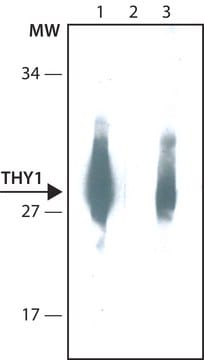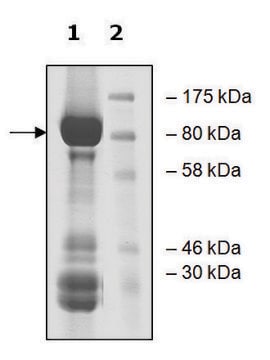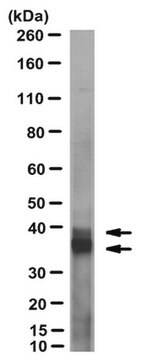推荐产品
生物来源
human
重组
expressed in baculovirus infected Sf9 cells
方案
≥90% (HPLC)
≥90% (SDS-PAGE)
表单
liquid
分子量
~29.8 kDa
包装
pkg of 5 μg
杂质
endotoxin, tested
NCBI登记号
运输
dry ice
储存温度
−70°C
基因信息
human ... PCNA(5111)
一般描述
PCNA (proliferating cell nuclear antigen) gene is mapped to human chromosome 20p12.3 and encodes a scaffolding protein. PCNA is a homotrimeric protein known to localize in the nucleus. The PCNA ring has a central cavity that is large enough to allow the dsDNA to slide freely along it.
生化/生理作用
Proliferating cell nuclear antigen (PCNA) has its main function in DNA replication and repair mechanism. Itsignificantly maintains the longevity of mature neutrophil granulocytes. Upregulation of the PCNA gene is observed in cervical squamous cell carcinoma. PCNA supports cell survival by elevating metabolism flux. This gene expression is known to offer resistance to chemotherapy. Expression of PCNA or cyclin or polymerase delta auxiliary protein is elevated in the nucleus during late G1 phase immediately before the onset of DNA synthesis, becoming maximal during S-phase and declining during G2 and M phases. PCNA/cyclin may act as an auxiliary protein of DNA polymerase-delta to play a fundamental role in the initiation of cell proliferation. Recombinant PCNA was expressed with a 6x His tag in sf9 insect cells and purified by proprietary chromatographic techniques.
外形
Sterile filtered; 5 μg/5 μl in 50 mM Tris-Acetate, pH 7.5, 1 mM EDTA, and 20% Glycerol.
重悬
Centrifuge the vial prior to opening. Avoid freeze-thaw cycles.
Junko Odajima et al.
PLoS genetics, 12(11), e1006429-e1006429 (2016-11-10)
E-type cyclins (cyclins E1 and E2) are components of the cell cycle machinery that has been conserved from yeast to humans. The major function of E-type cyclins is to drive cell division. It is unknown whether in addition to their
Simran Kaushal et al.
Cell reports, 27(4), 1151-1164 (2019-04-25)
Common fragile sites (CFSs) are genomic regions that display gaps and breaks in human metaphase chromosomes under replication stress and are often deleted in cancer cells. We studied an ∼300-bp subregion (Flex1) of human CFS FRA16D in yeast and found that
Proliferating cell nuclear antigen prevents trinucleotide repeat expansions by promoting repeat deletion and hairpin removal.
Beaver JM
DNA Repair, 48, 17-29 (2016)
Fahad R Ali et al.
Development (Cambridge, England), 141(11), 2216-2224 (2014-05-14)
Generation of neurons from patient fibroblasts using a combination of developmentally defined transcription factors has great potential in disease modelling, as well as ultimately for use in regeneration and repair. However, generation of physiologically mature neurons in vitro remains problematic.
Promoter methylation of GATA4, WIF1, NTRK1 and other selected tumour suppressor genes in ovarian cancer
Chmelarova M, et al.
Folia Biologica (Praha.), 59(2), 87-87 (2013)
我们的科学家团队拥有各种研究领域经验,包括生命科学、材料科学、化学合成、色谱、分析及许多其他领域.
联系技术服务部门








